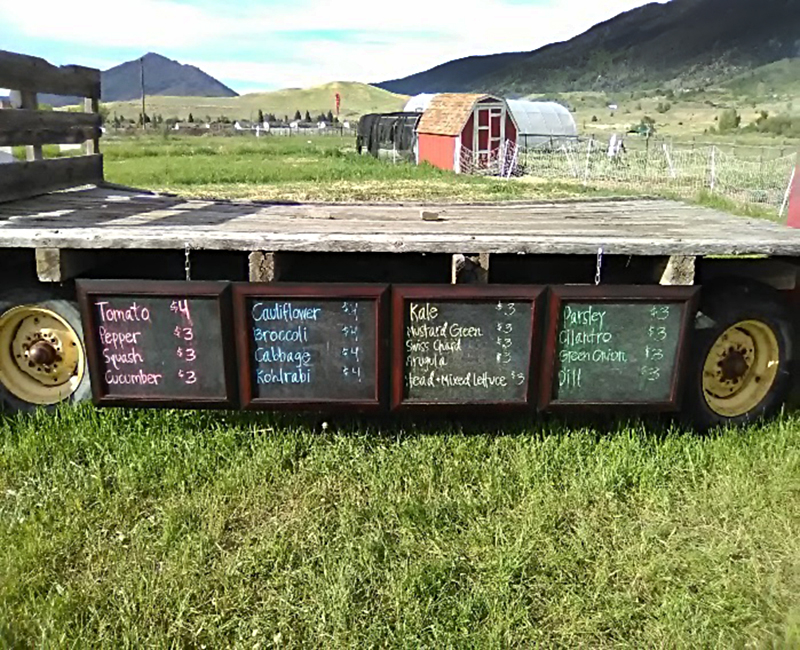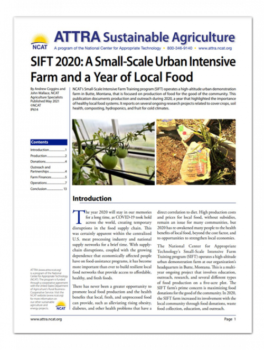SIFT 2020: A Small-Scale Urban Intensive Farm and a Year of Local Food
By John Wallace and Andrew Coggins, NCAT Agriculture Specialists
Abstract
NCAT’s Small-Scale Intensive Farm Training program (SIFT) operates a high-altitude urban demonstration farm in Butte, Montana, that is focused on production of food for the good of the community. This publication documents production and outreach during 2020, a year that highlighted the importance of healthy local food systems. It reports on several ongoing research projects related to cover crops, soil health, composting, hydroponics, and fruit for cold climates.
Contents
Introduction
Production
Donations
Outreach and Partnerships
Farm Finances
Operations
Conclusion
Introduction
The year 2020 will stay in our memories for a long time, as COVID-19 took hold across the world, creating temporary disruptions in the food supply chain. This was certainly apparent within the centralized U.S. meat processing industry and national supply networks for a brief time. With supply-chain disruptions, coupled with the growing dependence that economically affected people have on food-assistance programs, it has become more important than ever to build resilient local food networks that provide access to affordable, healthy, and fresh foods.
There has never been a greater opportunity to promote local food production and the health benefits that local, fresh, and unprocessed food can provide, such as alleviating rising obesity, diabetes, and other health problems that have a direct correlation to diet. High production costs and prices for local food, without subsidies, remain an issue for many communities, but 2020 has re-awakened many people to the health benefits of local food, beyond the cost factor, and to opportunities to strengthen local economies.
The National Center for Appropriate Technology’s (NCAT) Small-Scale Intensive Farm Training program (SIFT) operates a high-altitude urban demonstration farm at our organization’s headquarters in Butte, Montana. This is a multi-year ongoing project that involves education, outreach, research, and several different types of food production on a five-acre plot. The SIFT farm’s prime concern is maximizing food donations for the good of the community. In 2020, the SIFT farm increased its involvement with the local community through food donations, waste food collection, education, and outreach.
Production
Over time, the SIFT demonstration farm continues to become more productive as we expand growing areas and mitigate crop losses. In 2020, a year in which the demand for local food skyrocketed, the SIFT farm’s ability to address community food issues was greater than ever. As the effects of global warming have become more evident, protecting crops from extreme weather has become a major focus for SIFT. Extreme weather events this year varied widely, from heavy snow in June to drought by late July. Our capacity to extend the season and protect vulnerable crops has grown significantly due to the completion of two new high tunnels, which have proven very effective in our region of Southwest Montana.
| Crop | Yield in Pounds | Price per Pound | Estimated Value |
| Beans | 50.70 | 6 | $304.20 |
| Beets | 10.00 | 6 | $60.00 |
| Bok Choy | 46.50 | 6 | $279.00 |
| Broccoli | 5.00 | 5 | $25.00 |
| Cabbage | 5.00 | 5 | $25.00 |
| Carrots | 102.00 | 4 | $408.00 |
| Cucumber | 132.25 | 4 | $529.00 |
| Green Garlic | 3.00 | 3 | $9.00 |
| Garlic Heads | 37.00 | 3 | $111.00 |
| Garlic Scapes | 3.00 | 5 | $15.00 |
| Green Onion | 2.25 | 4 | $9.00 |
| Herbs | 1.00 | 16 | $16.00 |
| Hydro Basil | 1.00 | 16 | $16.00 |
| Hydro Lettuce | 2.00 | 8 | $16.00 |
| Kohlrabi | 70.50 | 4 | $282.00 |
| Lettuce | 32.15 | 8 | $257.20 |
| Melons | 7.00 | 6 | $42.00 |
| Microgreens | 3.00 | 20 | $60.00 |
| Onion | 23.00 | 4 | $92.00 |
| Peas | 46.00 | 6 | $276.00 |
| Peppers | 1.00 | 6 | $6.00 |
| Pumpkin | 5.00 | 4 | $20.00 |
| Radish | 125.75 | 3 | $377.25 |
| Rhubarb | 5.00 | 3 | $15.00 |
| Specialty Greens | 111.85 | 10 | $1,118.50 |
| Squash | 305.50 | 4 | $1,222.00 |
| Tomato | 32.25 | 4 | $129.00 |
| Turnip | 47.50 | 6 | $285.00 |
| TOTAL | 1,216.20 | $6,004.15 | |
| Note: Prices are estimated based on historical farmers market sales data from 2015-2018. We value our produce just below relative organic prices and above conventional. Our farm is not certified organic, but we do market our produce as fresh, local, and chemical-free. These prices are comparable to prices at a local farmers market.
* Garlic yield recorded is the amount that was donated. A portion of the harvested garlic was reserved to seed the following year’s crop. **Specialty Greens consist of kale, mustard, arugula, chard, and spinach. |
|||
Figure 1. Pounds of Produce Grown at SIFT Farm, 2018-2020

Four different varieties of bush beans grown in High Tunnel 3: Dragon’s Tongue, Provider, Carson, and Romano Purpiat. Photo: NCAT
The SIFT farm has more than doubled its production in pounds of food since 2018, as a direct result of expanded high tunnel production. In 2018, we had only two of our original hoop houses in production, because the other two had been removed in preparation for construction of two new high tunnels. The first new high tunnel was put into production in 2019. By 2020, both of our new high tunnels were complete and in production. Though we plan to erect one more high tunnel over a portion of the kids’ plot, it will result in little expansion of the growing area. Consequently, it is unlikely that the SIFT farm will continue on a growth trend of the same magnitude during future years. Production growth going forward will likely be a result of more efficient farming practices, such as maximizing the growing season and increasing soil amendments.
There were three crops that produced exceptionally well at the SIFT farm in 2020, and that gave insight into how to make the farm more productive. The carrot crop did exceptionally well this year due to successful management of weed pressure. Carrots are highly susceptible to weed pressure because their germination period is so long and their first leaves to emerge are so small. Through cover cropping and diligent weeding, we have gotten a better handle on the quack grass that formerly dominated much of the field. Another factor that led to a healthy carrot crop was the timing of the seeding. Whereas most years we have aimed at growing multiple successions of carrots, this year we seeded the entire block at the same time. Instead of forcing an early crop of carrots, we waited until late June to seed, when soil temperatures were significantly higher. Though this delayed our first carrot harvest, it shortened the germination period, making our weeding efforts more effective.
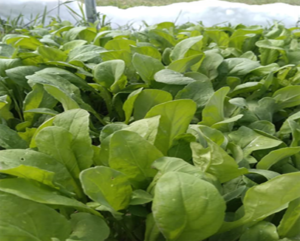
Spinach growing in early June that was protected from a late snowstorm by the high tunnel. Photo: NCAT
The beans that we grew in High Tunnel 3 are an example of what proper nutrient management can accomplish. Specifically, High Tunnel 3 benefits from having the farm chickens overwinter there. The manure they leave behind has contributed to significant increases in nitrogen for the soil in that high tunnel. This was evident in a robust bush bean crop this year. In general, soil tests from across the farm show a deficiency in nitrogen. We use many methods to increase nitrogen in the soil, such as legume cover crops, compost, and a foliar spray of fish emulsion; however, the chicken manure has had the most positive results, as highlighted in production from High Tunnel 3. This was in contrast to 2017, when we lost the entire bean crop to a very early hard frost. Our original high tunnels were not effective in protecting warm-season crops from hard frosts, but the new high tunnels have allowed for a longer period of frost protection that extends the growing and harvest seasons.
Specialty greens such as spinach, kale, mustard, arugula, and chard have always been successful spring crops at the SIFT farm, but this year’s success with them highlights the importance of seeding densities and harvest schedules. All these crops can be harvested multiple times during the season if they are grown with the intent of maximizing yield. Although a dense seeding of kale can produce an excellent baby kale that is tender and flavorful, the typical technique for harvesting baby kale is to clear-cut it. This technique causes the second growth to be leggy. We found that leaving more space in the seeding allows a more mature plant to develop; the mature leaves can then be selected as they become available without the kale becoming full of stems, which are not palatable. This allows for continuous harvesting throughout the season, although it means that the crop must be managed often. By getting multiple harvests off our greens using this growing technique, we exceeded our yield expectations for the year.
Donations

A donation to the food bank, consisting of carrots, squash, and cucumbers. Photo: NCAT
The primary purpose of the SIFT demonstration farm is to provide food for the local community. This year, we grew a total of 1,216 pounds of food on the SIFT farm and donated it to local community organizations that address food security issues. The stress on the community caused by the pandemic created a high demand for food assistance programs, so these donations were especially meaningful this year.
We donated most of the vegetables we grew to the Butte Emergency Food Bank. These were bulk items that were easily portioned and distributed. Youth participants in the YMCA summer program spent two mornings a week helping in the kids’ plot. Each week we taught them how to harvest their own vegetables, which they were allowed to take home. We also supplied YMCA program participants with salad greens and radishes for their lunch as part of the program.
We donated smaller amounts of vegetables and specialty greens to the SNAP-Ed nutrition program. The program used these items in cooking classes, so that SNAP recipients could learn to make their food dollar go further while eating healthy.
Continental Gardens is an assisted-living facility located adjacent to the SIFT farm. As part of an initiative to increase fresh food in schools, hospitals, and nursing homes, we packaged individual food baskets for 15 residents at the facility throughout the summer.
| Butte Emergency Food Bank | SNAP-ED | Continental Gardens | YMCA | Butte Mutual Aid Network |
| 827 | 62 | 182 | 109 | 36 |
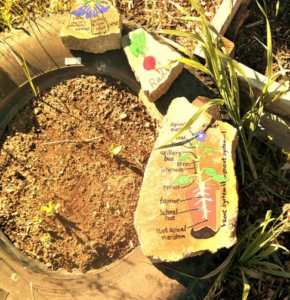
Rock art in our kids’ plot demonstrates the anatomy of plants. Photo: NCAT
Outreach and Partnerships
YMCA
The local YMCA has partnered with NCAT since 2017 to provide gardening and farming exposure and education for young kids at the SIFT demonstration farm. This year, Energy Corps member Lilianna Bento began her term of service with the SIFT farm in May and immediately set to work on the YMCA garden, planting peas, green onions, lettuce mixes, radishes, and spinach in the raised beds and pollinator mixes in and around the two open beds. These mixes included native grass, wildflowers, winter peas, buckwheat, and vetch. The SIFT farm created rock art illustrations with information about the vegetables growing in the raised beds, to add artistic appeal.
The YMCA summer program for kids began on June 11, 2020. Initially, the children planted additional areas with spinach, lettuce, carrots, beets, peas, and hollyhocks. In addition, they harvested the radishes planted in May, watered everything in sight, and learned that the basic components of sun, water, soil, and air are needed for plants to grow. In all, we had more than 70 children visit the farm in June. With everything planted and the pollinator garden beginning to flower, July became the month for watering, weeding, and lessons from Lilianna on worms and vermiculture, plant life cycles, seeds, pollination, and weeds. We estimate that 83 children visited the farm in July, over the course of seven YMCA visits. August was characterized by constant harvesting of fruit and vegetables throughout the SIFT farm and continued education for the children on soils, harvesting, raised-bed maintenance, and seed saving. With school approaching, this was the final month for YMCA visits, and visits trailed off toward the end of the month, but we still had 69 children visit in August. More than any year so far, this year showed the importance of providing hands-on education (with appropriate precautions) because so many opportunities were not available due to COVID-19.
4-C’s Butte
4-C’s Butte is a community organization that coordinates childcare providers in the area and offers training courses. This year, 4-C’s partnered with NCAT to coordinate a gardening workshop where childcare providers could learn how to incorporate gardening into child education. Restrictions from the pandemic limited the number of childcare providers we could host on-site; however, over the course of April and May we invited interested parties to tour the farm to learn about season extension and selecting plant varieties for Butte. There were three separate groups that attended, totaling four adults and six children. These tours focused on low-cost solutions for season-extension tools and on selecting varieties that grow well in our region. For the children who participated, we led a tour of the greenhouses, talked about compost, and seeded plant starts.
SNAP-Ed Nutrition Education
SIFT also partnered again this year with the SNAP-Ed Nutrition Program, which supports low-income Montanans in “making the healthy choice the easy choice” through a dual focus on nutrition and physical-activity education. SIFT was involved this year with two series of classes. With the vegetables we donated to the program, Abbie Phillip was able to incorporate local produce into her CREATES Cooking class, which features scratch cooking at home using pantry items. The course is designed to boost participants’ confidence to tackle their nutrition challenges. We also set up a workshop and SIFT farm tour to accompany a class in another SNAP-Ed education series, Eating Smart, Being Active. In this educational series, participants set goals and master key nutrition concepts as part of a healthy lifestyle. The focus of this particular session was to encourage healthy eating and growing your own food. The nutrition class was held at SIFT farm neighbor Continental Gardens, an assisted-living facility. During this workshop, we discussed the regenerative soil methods currently implemented on the farm and how healthy soil contributes to nutrient-dense foods. We did this by showcasing the use of bio-nutrient-density meters and discussing the effect they could have on the future of organic produce.
Montana Tech
A persistent question in Butte, Montana, where the SIFT farm is located, is how to effectively remediate contaminated soil. Past mining operations in and around the community have left heavy metals that are often prevalent in area soils. Montana Technological University (Montana Tech), also located in Butte, has become a partner with NCAT in studying plant uptake of lead and arsenic. This year Shyla, a student working on her ecological restoration certificate, volunteered her field hours to help SIFT address the concern of heavy metals detected on an asphalted lot to the North of the farm. To examine the issue, she set up five test plots in which she grew a mix of cover crops. Going forward, she will be looking at how these cover crops uptake heavy metals and whether growing particular cover crops could be an effective method for restoring contaminated land to agricultural use.
Farm Finances
Income
As we look at the financial aspect of the farm in 2020, it is evident that income declined significantly this year. This was because we canceled our formal plant sale, which typically generates $800 to $1,000 in June. This annual sale usually allows us to recover our seed costs for the farm, which average $400 to $500. In 2020, only a limited number of plants were sold to those who reserved them and could pick them up in a safe manner. The unsold plant starts were used as transplants for the farm and the YMCA kids’ plot. However, overall income remained similar to 2019 due to the increased amount of food donated.
| Income | |
| Estimated value of produce donated | $6,004.15 |
| Eggs sold/donated | $83.82 |
| Plant sale | $112.15 |
| NRCS – EQIP grant payment | $1,395.00 |
| Total Income | $7,595.12 |
| Expenses (excluding labor) |
|
| SIFT operational costs (minus high tunnel costs) | ($2,295.27) |
| Specific high tunnel costs associated with EQIP grant | ($471.82) |
| NorthWestern Energy (Electricity costs) | ($221.04) |
| Butte-Silver Bow Water Division | ($903.34) |
| Total Expenses | ($3,891.47) |
| Balance | $3,703.65 |
Utilities
Utilities account for about 30% of total expenses at the SIFT farm. Electricity costs were minimal at only $221 for 2020. The electricity costs are highest during the winter, when heat lamps and stock water heaters are running. However, our summer demands are slowly increasing due to increased hydroponic production. Solar chargers have proved effective for powering air pumps, but they are not reliable enough for water pumps at this time. The hydroponics system also needs to be well-ventilated, so a new vent fan was installed in the greenhouse this year.
Water utility costs are metered through a municipal system. Water usage for the SIFT farm has been on a decline as we have been working to increase the efficiency of our micro-irrigation system. Because there is little room to increase efficiency further, we expect the SIFT farm’s water expenses to level out, although increased production and drought conditions may lead to a slight future increase in water use.
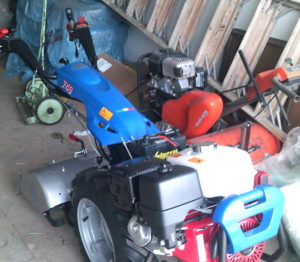 New SIFT BCS 749 with tiller attached. Photo: NCAT |
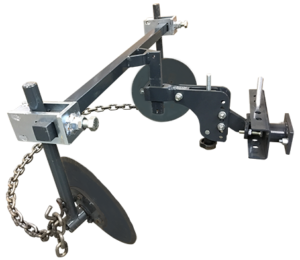 BCS bed-shaper attachment. Photo: montanabcs.com |
Equipment
With much of our existing equipment dated and in need of repair, we decided it was time to invest in equipment that would better fit our needs. Our tiller and mower have depreciated to the point where they have no asset value to us, and the maintenance costs for them are rising. Our Husqvarna tiller currently needs a new drive cable installed, estimated at $110. This piece of equipment no longer serves our purposes well. Instead of using it, we have been renting a high-power, reverse-tine tiller for $30 an hour, which can get more work done in a fraction of the time. Rental fees for this tiller totaled $231. One major drawback of relying on rental equipment is having to do all the tilling, bed preparation, and seeding at once, while the tiller is on-site. Often, projects were delayed until everything was prepared for the rental equipment. The result of this delay was that crops could have gone in earlier in some places or planting areas could have been prepared and amended better.
Our Nortrac 25-hp tractor has depreciated similarly over the years and currently is valued at just $1,314, while the cost to replace the clutch is estimated to be $3,000. Though this piece of equipment is useful for its bucket attachment when it is operational, the tractor’s other attachments are rendered unusable by the machine’s faulty hydraulic arm.
BCS Tractor and Attachments
When a small funding opportunity became available to the SIFT farm through NCAT in 2020, we decided to purchase a BCS walk-behind tractor and accessories for it. There were several reasons for this, including the fact that although hiring a Berreto tiller three to four times a year was fine, we had to prepare several areas on the SIFT farm at once to make rental of the machine cost-effective. Also, the hired machine did not come with additional attachments. In addition, the SIFT Husqvarna, which is currently due for repair, is a lighter machine that cannot cope with certain conditions at the farm. Also, both the Husqvarna and SIFT’s Cub Cadet mower have no remaining depreciation value.
Given these considerations, we felt the new BCS 749 walk-behind tractor would be the best investment for the SIFT farm. It is not the highest-powered tiller offered, but it is close. Plus, it will be able to fit through the doors of our greenhouses. Having more effective equipment will reduce labor hours spent broad forking, weeding, and raking our beds, or help us avoid using rental equipment to perform these jobs. It also will allow us to seed crops and prepare successions more easily, and quicker. Our investment in the BCS tractor includes a 26” tiller and a bed shaper attachment. The tractor’s wheels can be extended to prevent driving through freshly tilled and shaped beds. Also, the wheels can be weighted to keep the machine stable and balanced.
Operations
Irrigation
Water usage at SIFT’s demonstration farm has decreased over the last couple years, despite the growth of the farm. Until 2016, water usage increased annually as we continued to expand the area in production while dealing with leak issues caused by dated irrigation equipment. We have since seen a decrease in our water usage, due to three notable factors. First, we invested in a higher-quality drip line to replace the old, damaged line. When there are leaks in a system, it causes pressure variations that not only waste water, but unevenly distribute the water to the plots. The new line avoids these problems.
 A bed of Mizuna mustard greens, ready to be harvested. Photo: NCAT |
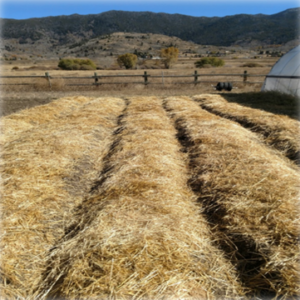 Garlic beds that have been well mulched with straw to hold in moisture. Photo: NCAT |
Secondly, we have better timed our watering schedules to match the season, growing area, and crop. A great strategy is “less, more often.” Using a timer that can be programmed to run four times a day is useful during germination stages and for hot summer days. In the high tunnels, where lettuces and greens were growing, we initially ran the water for four minutes, twice a day. On hot days, when the high tunnel sides were rolled up, we noticed the plants were starting to look a little parched. Instead of watering for longer, we found that switching to two minutes, four times a day, did the trick. The outdoor plots need more water than the high tunnels and are dependent on the weather and season. The outdoor irrigation has been split into two zones. This helps keep pressure in the system so that we can evenly irrigate and increase efficiency within the zones.
Lastly, regenerative methods such as cover cropping, mulching, and adding compost have helped to increase organic matter in the soil. Our goal is to keep living roots and soil cover for as much of the year as possible, as well as minimize tillage when feasible.
At this point in time, our water usage is expected to level out. There is little further capacity to improve efficiency, other than on our cover crop test area. There, the need for water is increasing as the cover crop test area has been strained by drought year after year. Currently it is overhead-irrigated, which is water-intensive. One idea for increasing the water efficiency for our cover crop test plot is to attach a solar pump to our rain barrel and run a soaker line over the plot.
High Tunnel Efficiency
Two newly built Rimol high tunnels have replaced our four original high tunnels. This addition slightly increased the square footage of the farm that is in high tunnel production. In many ways, the Rimol high tunnels outperform the pre-existing ones that they replaced. The steel frames hold up well in high winds, and, most importantly, the wire-locking feature for the poly-film prevents tearing at the edges. It was tearing of the poly-film that ultimately led to the complete loss of one of the original high tunnels when a strong gust tore the entire skin off.
The larger cavity of the Rimol high tunnel allows warm air to pool in the top, while the sides can be rolled up to vent the ground on hot days. This feature is worth noting because our main complaint about the previous high tunnels was that they did not trap enough heat or moisture to retain warmth overnight. The average indoor temperature was only one to five degrees warmer than outside, depending on the weather conditions. In our location, we occasionally have the risk of frost even on summer nights, especially on clear nights under a stagnant high atmospheric pressure. This results in a significant temperature drop at night which, coupled with a strong mountain inversion, can pull freezing air off the Continental Divide. This creates a river of cold air that snakes down from a geographical area northeast of Butte, known as Elk Park. The river of cold air makes its way through the SIFT farm as it settles along the East Ridge. This phenomenon is usually localized to a region known as “The Flats,” which sits at the valley floor. However, Uptown Butte, which rests above The Flats on the flank of a hill, often finds itself above the thermocline of the inversion, where the air can be much warmer. The new high tunnels have shown themselves to be much more effective in trapping heat overnight than the old ones were. The average indoor temperature has ranged between four and 12 degrees warmer than the outdoor temperature. Much of this range seems to depend on how long the sides are rolled down and whether the high tunnel receives direct sun during the day.
Not only does the addition of the new high tunnels increase our protected growing area, but they have also extended our growing season this year by about 45 days. These greenhouses are effective tools for growing early, cold-season vegetables. Imidn 2020, we seeded in mid-to late April, and hand-harvested from May through July. The frost-tolerant plant varieties that we chose endured the chaotic Montana spring weather and turned out to be the best-yielding early crop grown on the SIFT farm to this date.
Pollinators

Bees taking shelter in a sunflower planted to encourage pollinator activity. Photo: NCAT
One of the SIFT farm’s goals this year was to increase pollinator habitat. One way we have accomplished this is by increasing the cover cropping on the farm. The addition of more growing space allowed us to include one more cover crop in the outdoor crop rotation. These cover crops include pollinator species such as phacelia and hairy vetch. The phacelia brings a long-lasting bloom that is a haven for bees, while the hairy vetch simultaneously attracts insects and fixes nitrogen. We are also using buffer crops, which are grown in between our outdoor blocks. There is not much difference between these and a traditional cover crop, other than that we have selected a different cocktail mix for the buffer crops, based on a different set of goals. Although our cover crop mix was primarily chosen to increase organic matter and fix nitrogen, buffer crops are typically used to reduce insect and disease damage and keep down weed pressure.
To achieve those goals, we selected species that have vigorous growth, such as millet, which we accompany with buckwheat. Buckwheat is a great pollinator but does not take frost. This means our buffer crops are seeded after the last threat of frost, whereas our cover crop cocktail can germinate at colder temperatures.
Just as high tunnels keep heat in, they often keep pollinators out. This issue can be remedied by growing what we call “flagging crops.” These are flowers grown strategically by the doorways and sides of the high tunnels to encourage pollinators to enter. Sunflowers are great for this purpose. This year, the pollinators faced alarming weather circumstances. We were hit with a late snowstorm that dropped 8” of heavy snow on June 8, 2020. The weight of the snow buckled and destroyed many early spring flowers in our area, such as lilacs. The following week, we had a windstorm that damaged a greenhouse and toppled a local farmer’s hives. This disturbance delayed pollinators from showing up until well into July. However, when they did arrive, they relished their pollinator sanctuary.
Compost
We currently have three different ongoing demonstrations of composting methods. The most reliable is a three-bin system. The process of fully cooking the compost in a bay takes anywhere from three weeks to two months, depending on the levels of nitrogen included in the mix. High amounts of nitrogen cause the pile to heat up more quickly, and speed the composting process.
Since the SIFT farm partnered with the Butte Emergency Food Bank to divert food waste heading to the landfill, we receive more organic matter than we can handle in the existing three-bin system. To accommodate the additional compost material, we started a second composting method: a row compost system in our north lot. The quality of this compost has not been very high. This is likely due to the high content of undesirable materials, such as bread and citrus, that get diverted to the larger system. We are working on finding materials to help balance the carbon-to-nitrogen ratio of this compost to a more desirable 30:1. Because of the location of this compost row, away from a water source, and due to problems with pest invasions, we plan to build this row into a hügelkultur with wood chips and cottonwood logs. Hügelkultur is a growing method in which a hill is built over logs and organic debris that slowly break down. The decay releases nutrients and holds in moisture, while crops can be grown on top of the hill.
The third compost method that we use is designed to create the highest-quality compost. While our three-bin system favors bacterially dominated compost, the Biologically Enhanced Agriculture Management (BEAM) composting method is designed to create a compost that is fungal-dominant by a ratio of 5:1. Research shows that composts with higher fungal dominance are effective when applied to vegetable-production systems, even at lower rates. Producing this fungal-dominant compost is accomplished by alternating layers of carbon and nitrogen while allowing air and water into the pile via perforated poly tubing. This allows a slower, lower-heat composting reaction that favors fungal growth. Also, not turning the compost prevents the fungal matter from being disturbed, similar to the way that tilling a field would do. In an ideal environment, composting with this method can take up to a year, and it is likely to take even longer in regions like ours, where compost lies dormant during the winter.
Cover Crops
The SIFT farm’s cover crop area remains host to an important project, as we continue to monitor soil health improvements through yearly Haney tests, infiltration tests, observations, and tillage practices. The Haney test uses soil extracts to determine what quantity of soil nutrients are available to soil microbes. This test also evaluates soil health indicators such as soil respiration, water-soluble organic carbon, organic nitrogen, and their ratio.

Cover crops – Phacelia. Photo: NCAT
The eight-species cover crop mix that we used remained the same as in 2018 and 2019, with Yellow Blossom sweet clover, common vetch, Otana oats, annual ryegrass, Tyndal triticale, Purple Top forage turnips, and Lacy phacelia being broadcast onto sown winter peas with inoculant. We try to keep the sowing dates as close as possible to previous years, though dates can be weather dependent. We were slightly later than usual this year, with plots prepared May 27-29. The preparation included tilling the ground to incorporate residue and loosening the soil. We then drilled the winter peas and broadcast the cocktail mix. To secure the seeds, we raked them into the soil and rolled over the plot with a cultipacker. This tool is used to firm up the soil around the seeds so that they can germinate properly.
We try to keep our annual Haney testing within a time frame similar to previous years, while also considering the optimum time for sampling, given soil temperature and soil moisture. In 2020, the tests were taken on July 27, slightly earlier than the previous year’s tests on August 5. Table 5 has been updated and modified with 2020 results to account for what we feel are the key indicators within the Haney tests, based on current project work assessing similar data
for clients.
Last year’s SIFT publication, Continuing Lessons from a Small-Scale Urban Intensive Farm, went into detail on the concept behind the cover crop trial and its methodology. This year, water infiltration tests were done on August 4, and the southern plot’s residue was incorporated with a tiller on October 20, after both plots were mown down. As in previous years, certain species suffered, particularly with this dry summer, but we still had successes, with five of the eight varieties successfully establishing: peas, oats, triticale, phacelia, and fodder turnips. Again, this variability is the reason for using multi-species cover cropping, instead of relying on just one or two varieties that may or may not establish.
The main reason we concentrate on the Haney tests, water infiltration tests, and observations is that NCAT is increasingly becoming involved in project-related soil health assessment work with partners. Understanding the variations in results on a yearly basis—and why they occur—is of benefit on any scale. The water infiltration tests from SIFT are below (Table 4), and the Haney test summary follows (Table 5).
| North plot (2 tests – 2nd pour) — 5 minutes 5 seconds and 5 minutes 10 seconds |
| South plot (2 tests – 2nd pour) — 4 minutes 5 seconds and 4 minutes 20 seconds |
| SIFT Cover Crops | North Plot — Spring Tilled Only | SIFT Cover Crops | |||||||||
| Haney Tests | Soil pH | Soil Organic Matter | CO2-C ppm C | H2O Organic Nitrogen pp/m | H2O Organic Total N pp/m | H3A ICAP Sodium Na | MAC – Microbial Active Carbon | Organic C:N Ratio | Available Nitrogen lbs | Available Phosphorus lbs | Available Potassium lbs |
| 2017* | 6.8 | 3.6 | 45.5 | 16.5 | 27.8 | 20.6 | 19.9 | 13.9 | 80.4 lbs | 100.7 lbs | 244 lbs |
| 2018 | 6.7 | 2.3 | 18 | 11.8 | 15.1 | 19 | 15.1 | 10.1 | 25.3 lbs | 97.2 lbs | 233.3 lbs |
| 2019 | 7.1 | 2.2 | 17.9 | 9.4 | 11.1 | 21 | 15.6 | 12.1 | 24.4 lbs | 110 lbs | 252.7 lbs |
| 2020 | 6.6 | 2.9 | 18.3 | 19.4 | 23 | 18 | 14.6 | 6.4 | 36.9 | 109.5 lbs | 249.1 lbs |
| * Baseline figures over whole area before plots divided into North and South plots. | |||||||||||
| SIFT Cover Crops | South Plot — Spring and Autumn Tillage | SIFT Cover Crops | |||||||||
| Haney Tests | Soil pH | Soil Organic Matter | CO2-C ppm C | H2O Organic Nitrogen pp/m | H2O Organic Total N pp/m | H3A ICAP Sodium Na | MAC – Microbial Active Carbon | Organic C:N Ratio | Available Nitrogen lbs | Available Phosphorus lbs | Available Potassium lbs |
| 2017* | 6.8 | 3.6 | 45.5 | 16.5 | 27.8 | 20.6 | 19.9 | 13.9 | 80.4 lbs | 100.7 lbs | 244 lbs |
| 2018 | 6.6 | 2.1 | 19.6 | 12.2 | 14.7 | 19 | 13.1 | 12.2 | 21.9 lbs | 110.8 lbs | 252.8 lbs |
| 2019 | 7.1 | 1.8 | 14.9 | 11.4 | 13.8 | 17 | 13 | 10 | 26.3 lbs | 114.2 lbs | 265.6 lbs |
| 2020 | 6.7 | 2.2 | 18.7 | 19.7 | 24.7 | 18 | 15.1 | 6.3 | 39.4 lbs | 118.8 lbs | 239.5 lbs |
| * Baseline figures over whole area before plots divided into North and South plots. | |||||||||||
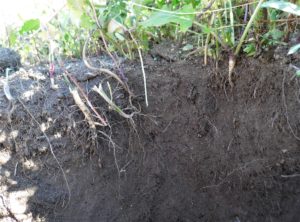 |
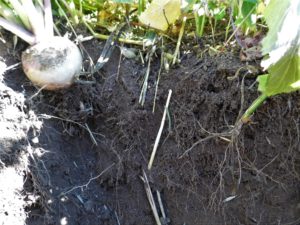 |
| A cross-section of root growth in the North Plot cover crop, left, and root growth inthe South Plot cover crop, right. Photos: NCAT | |
Fruit Tree Plot
The plan moving forward from 2019 was to infill the existing fruit tree area with our own replacement bushes grown from cuttings or seed wherever we had losses. Unfortunately, a very dry summer meant that the fruit trees did not grow much from the 2019 season. The only variety that it was really feasible to take cuttings from was the ‘Borealis’ honeyberry, but we have had no losses with this variety, and therefore no replacements were needed. Unfortunately, the ‘Borealis’ produced no fruit this year because the blossom was hit by late-season frosts – illustrating another challenge to growing fruit trees in this climate.
We completed a very simple 3-D fence to protect the trees from deer, and cardboard collars around the tree bases (which worked well to suppress weeds and help retain moisture) have been replaced with rocks to serve the same purpose.
Moving forward, the aim will be the same as before. We are eager to grow more bushes from existing stock through cuttings, grafting, and seeds. Throughout the summer of 2020, the bushes were watered daily, and we will continue this process until they can get big enough to source water themselves, even in a drought year.
This is the same practice we used with the native hedgerows around the edge of the SIFT farm, when the irrigation lines were removed in 2017. This decision was partly because an effective irrigation system had never been developed, and partly because we judged that most (though not all) of the bushes were of sufficient size that the root systems could source enough water even in dry years. The plants should be able to survive, because most of these fruit bushes grow wild in some very harsh climates around the world, without the aid of irrigation or additional water.
It is interesting to note which varieties do the best in this climate in any given year. Within the fruit tree area, the best performer this year has been the ‘Borealis’ honeyberry (an older variety). Meanwhile, in the native hedgerow area, Silverberries have been the most successful bushes. The important rule with fruit-producing trees and bushes is patience! Trees and bushes can sit semi-dormant for several years before the “right” season triggers dramatic growth. One only has to look at the tree rings in a sawn section of trunk to understand how little growth can occur in challenging years.
 |
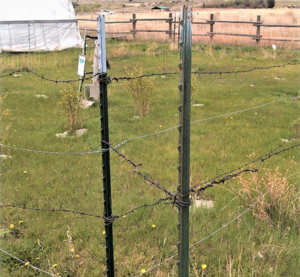 |
| ‘Borealis’ honeyberry flowering, left, and 3-D fencing around the fruit, right. Photos: NCAT | |
| Fruit Tree Plot, North to South | Variety | Year Planted | Number Planted | Number Remaining in 2020 |
| Line 1 | Nanking Cherries* | 2017 and 2018 | 10 | 8 |
|---|---|---|---|---|
| Line 2 | Carmine Jewel Cherries | 2017 | 5 | 2 |
| Juliet Cherries | 2018 | 5 | 4 | |
| Line 3 | Borealis Honeyberries | 2017 | 5 | 5 |
| Boreal Blizzard Honeyberries | 2018 | 5 | 3 | |
| Line 4 | Svetlana Honeyberries | 2017 | 5 | 3 |
| Boreal Beast Honeyberries | 2018 | 5 | 3 | |
| *Note: Nanking cherries are common across Montana and used here as a baseline planting. | ||||
Hydroponics
Our original hydroponics system at the SIFT farm operated until 2019, primarily growing basil and lettuce plants in an aerated solution of water and compost tea to see how far plants could really grow on this very simple nutrient diet. Although this was successful, we wished to assemble a donated microgreens system we obtained in 2019, which would make an excellent comparison between home-built and off-the-shelf systems. This commercial system had a value of several thousand dollars, albeit a system for microgreens that could easily be adapted to hydroponics. Given the size of this system, there would not be room for both it and the original hydroponics system. Rather than take up further valuable space in a separate room needed for plant starts, we dismantled the original system and built a new, compact system. Although the new system is much smaller overall, it still provides around 45% of the plant capacity of the old one.
In this system, the water/compost tea was never circulated, and therefore no water pump was required. Meanwhile, the air pump was solar-powered and obtained online for $35. This pump ran for at least six hours per day throughout the summer on the same set of rechargeable batteries, so no electricity was required.
 |
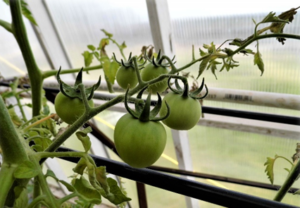 |
| Mini-hydroponics system being built, left, and ripening tomatoes in the new ebb-and-flow system, right. Photos: NCAT | |
In addition to building the smaller hydroponics system, our second goal in 2020 was to grow fruit in the hydroponics system, again just using compost tea as a nutrient base. Tomatoes were the obvious choice. Our goal was to Brix test this fruit and directly compare it with Brix test results from tomatoes grown in soil in High Tunnel 2.
It is important to point out that a refractometer primarily measures concentrations of sugar, protein, and carbohydrate via the Brix test. A high score might indicate high nutrition density, but it might not. The reason for this is that the other key influence on a Brix score is water, and the higher the water content of the fruit (or whatever is measured), the lower the concentration of sugars, proteins, and carbohydrates within the solution, so the lower the Brix score. To illustrate this, take a tomato off the vine and allow it to dry on a shelf for a few hours, then Brix test it against a tomato still on the vine (especially if the plant has just been watered). Assuming that they both had identical levels of sugar, carbohydrate, and protein to start with, the dried tomato should produce the higher Brix score. This is not because it is more nutritious than its counterpart on the vine, but because it now has a lower moisture (water) content, and therefore the sugars, carbohydrates, and proteins are more concentrated in the solution. Brix readings measure nutrient concentration. Consequently, a Brix test is not a definitive measure of the nutritional value of one fruit over another, but for our purposes (and assuming that the moisture content was similar between the hydroponically grown sample and the soil-grown sample), it was a useful indicator to see if the hydroponically grown tomatoes could match their soil-based counterparts, and also if compost tea could provide enough plant nutrients.
 |
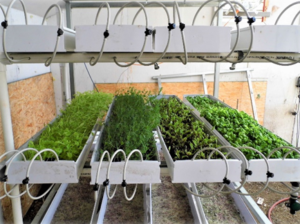 |
| Small solar-powered air pump, left, and four trays of micro-greens, right. Photos: NCAT | |
The results we obtained (Table 7) begin to address the question of whether hydroponically grown fruits and vegetables can be as nutritious as their soil-based counterparts. In our testing, the results for both systems were comparable.
| Date | Hydrophonic System | High Tunnel System |
|---|---|---|
| August 4 | 9 cherry (tomatoes) | |
| August 7 | 9.5 | |
| August 10 | 8-8.5 (borderline ripe) | |
| August 7 | 10 | 9-11 |
| August 4 | 9 | 10-10.5 |
Conclusion
Despite the logistical and weather-related challenges of the 2020 growing season, the SIFT demonstration farm increased production and completed several major projects, as well as continuing ongoing projects. Looking forward, we plan to continue to refine growing practices suited to our challenging high-altitude climate and build our relationships with community partners.
SIFT 2020: A Small-Scale Urban Intensive Farm and a Year of Local Food
By Andrew Coggins and John Wallace, NCAT Agriculture Specialists
Published May 2021
© NCAT
IP614
Slot 643
Version 050721
This publication is produced by the National Center for Appropriate Technology through the ATTRA Sustainable Agriculture program, under a cooperative agreement with USDA Rural Development. ATTRA.NCAT.ORG.
Related Resources
Videos:
Podcasts:
- Episode 140. The Haney Soil Test
- Episode 160. Hydroponic Trials at NCAT’s SIFT Farm
- Episode 165. SIFT Farm’s Unusual Year
- Episode 173. SIFT Farm’s Unusual Year. Part 2
- Episode 183. Demystifying Soil Health Indicators and Tests
Publications:
- Composting—The Basics
- Equipment and Tools for Small-Scale Intensive Crop Production
- Federal Conservation Resources for Sustainable Farming and Ranching
- High Tunnels in Urban Agriculture
- Season Extension Techniques for Market Gardeners
- SIFT 2018: Lessons from a Small-Scale Urban Intensive Farm
- SIFT 2019: Continuing Lessons from a Small-Scale Urban Intensive Farm
- Soil Health Indicators and Tests
- Start a Farm in the City

